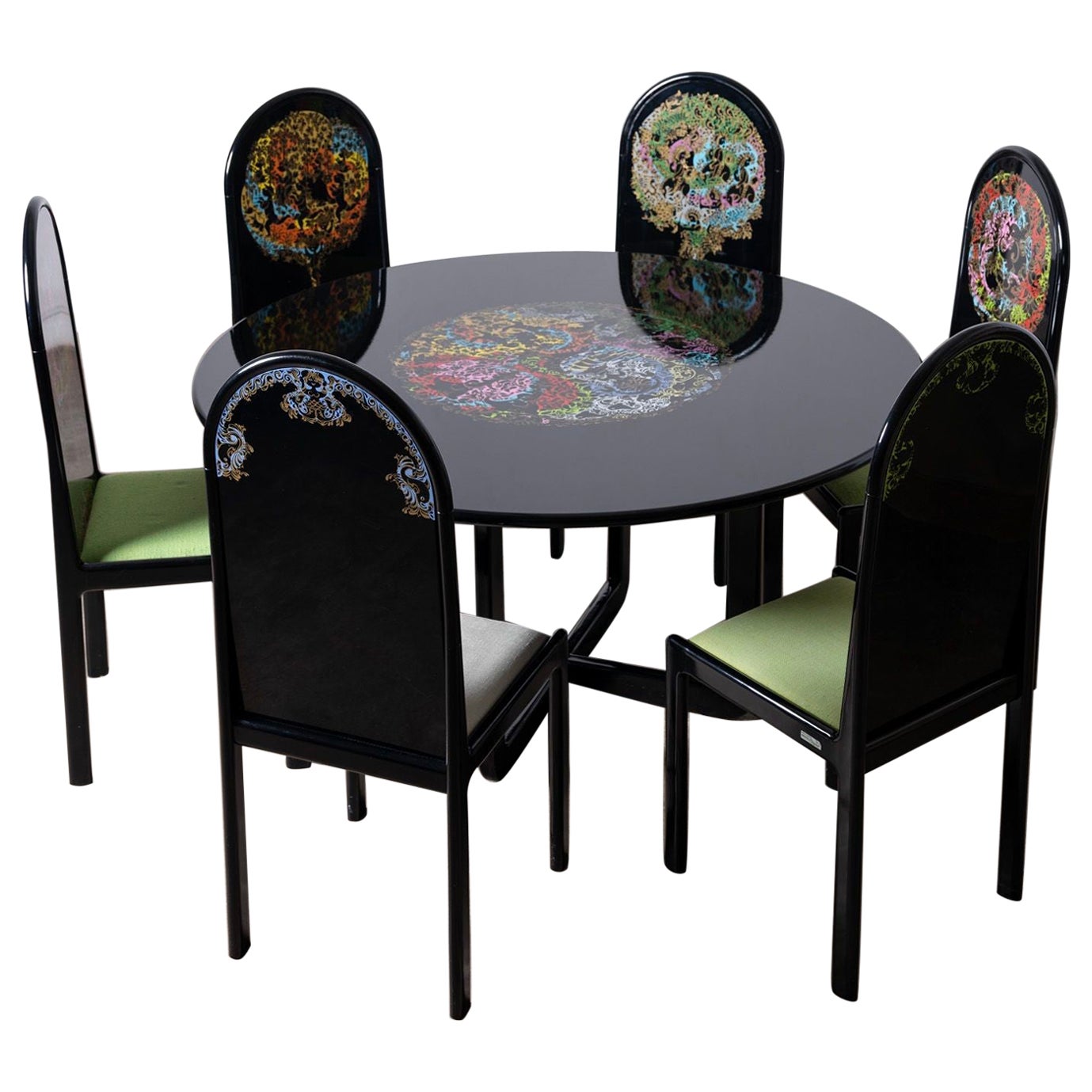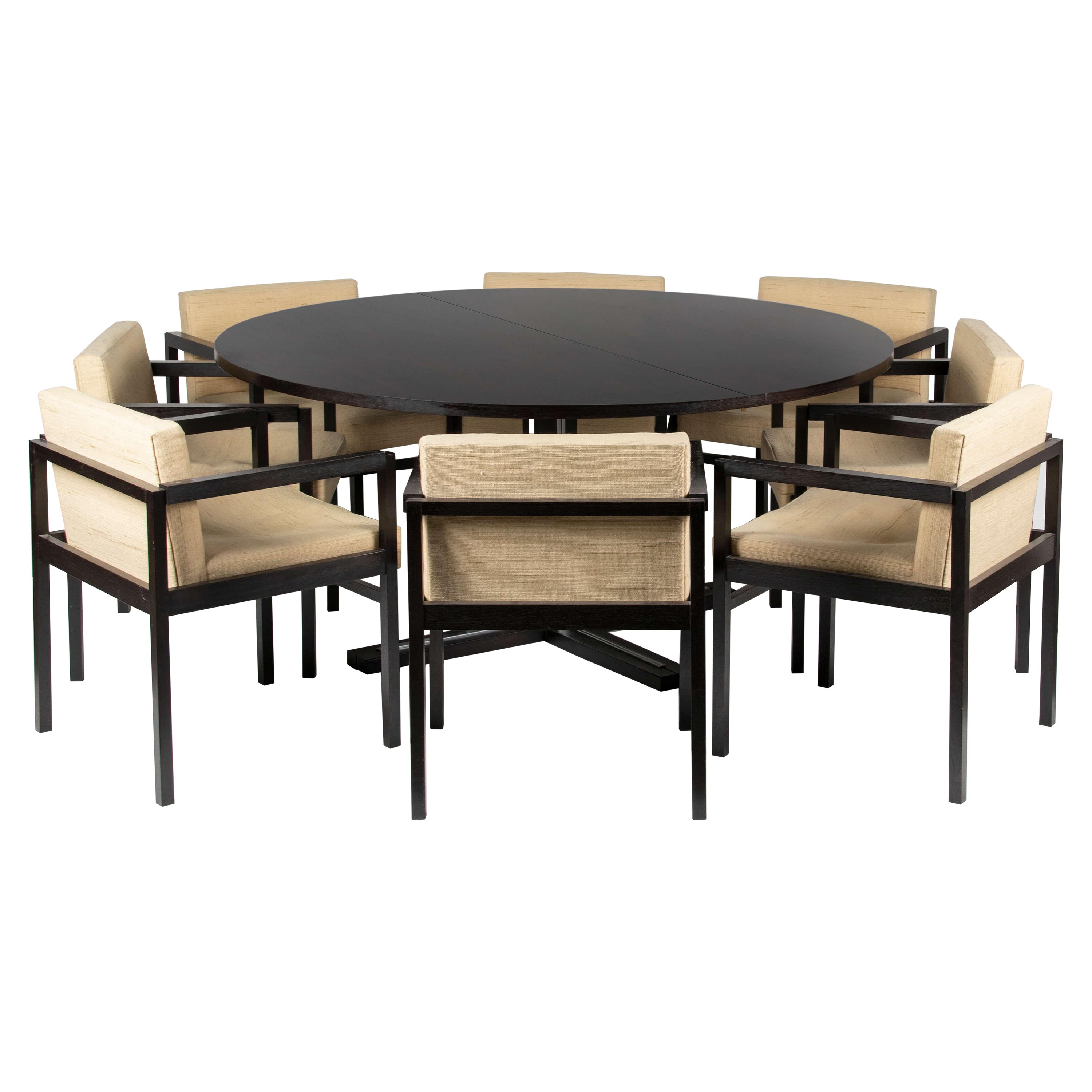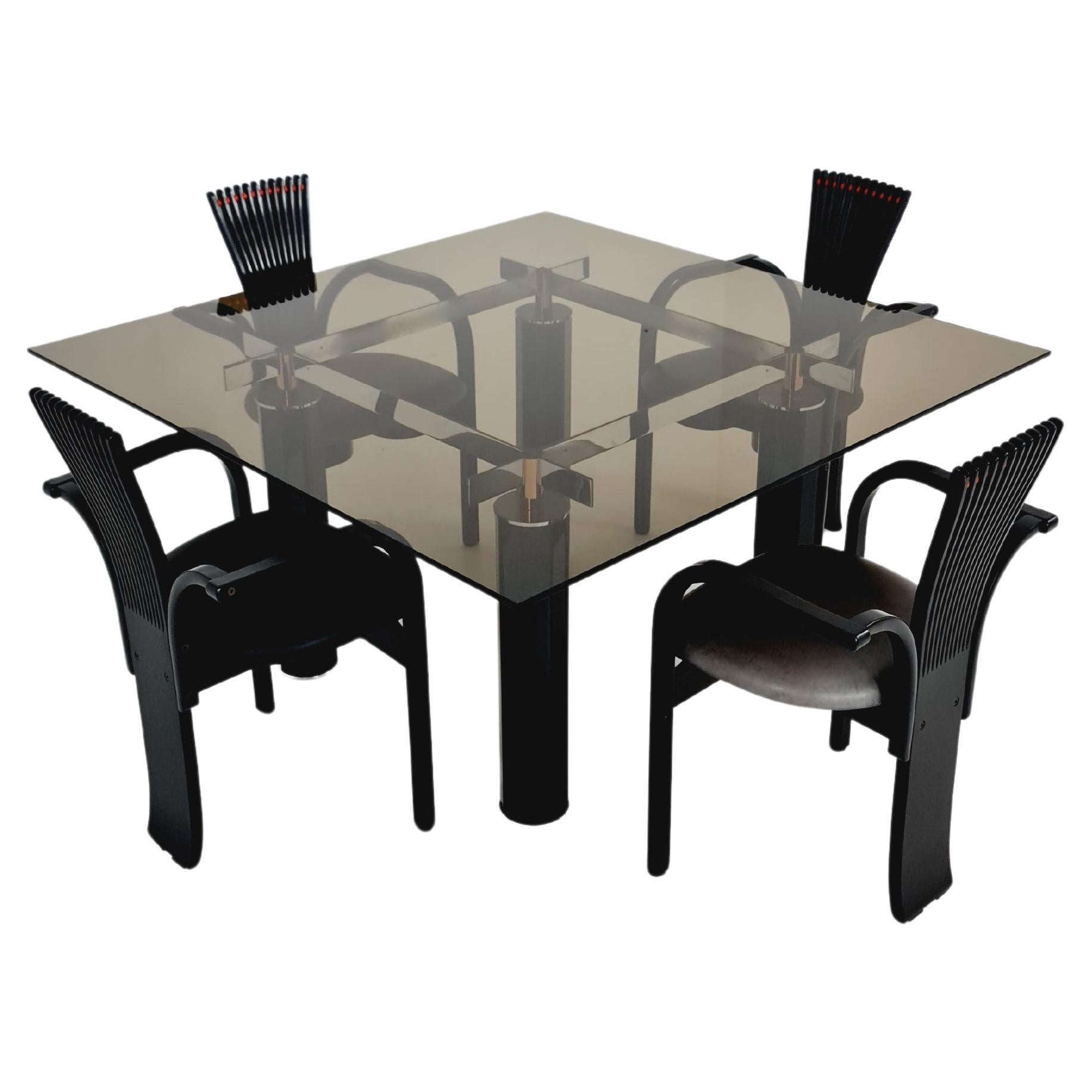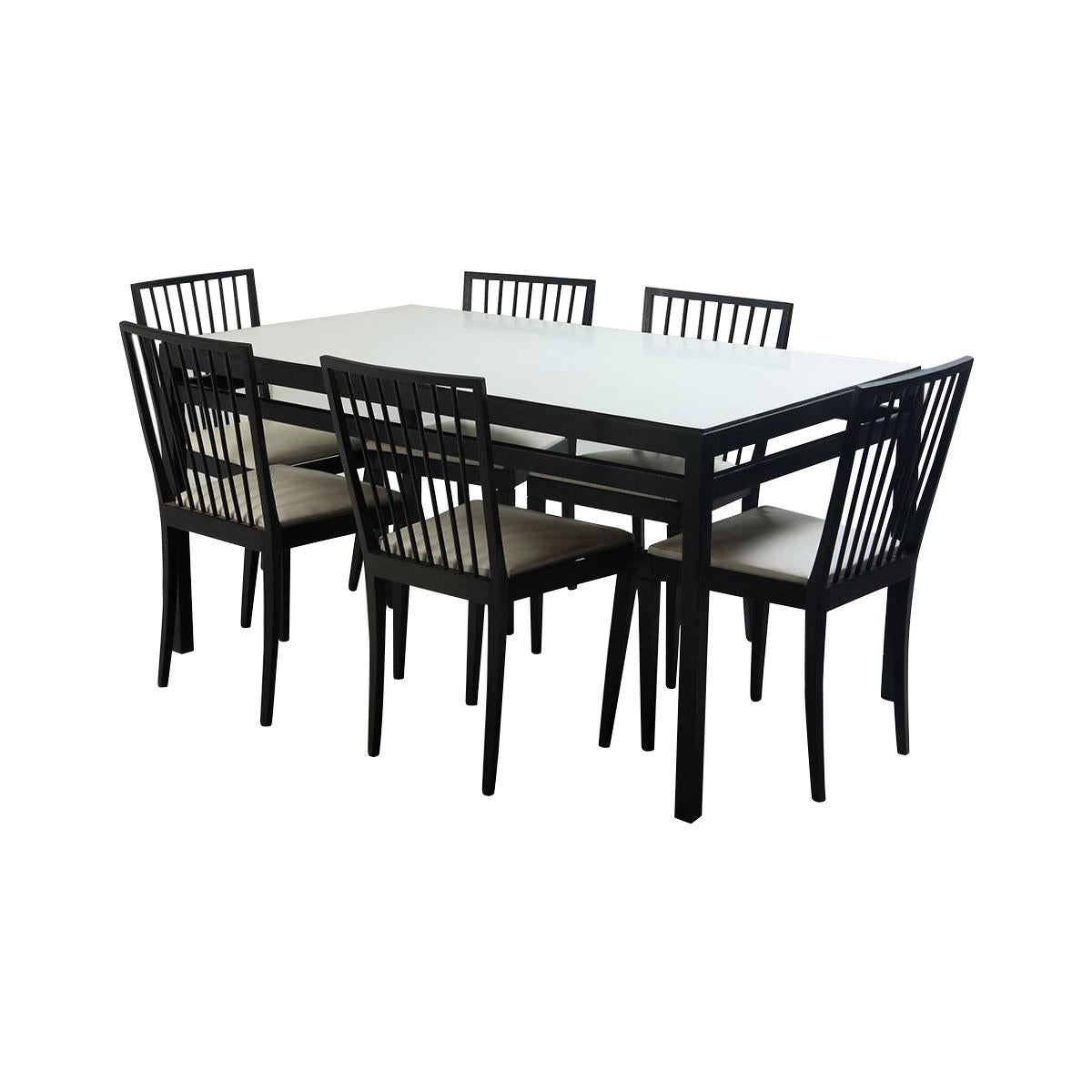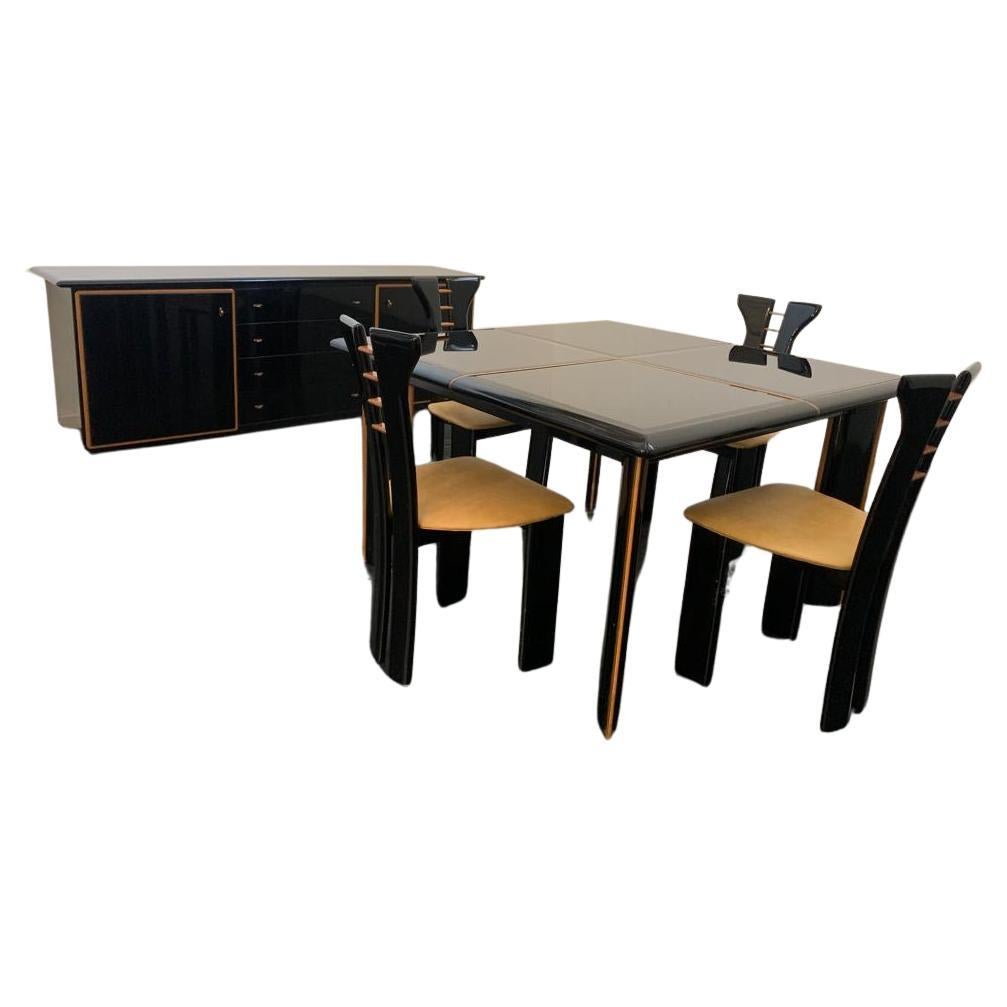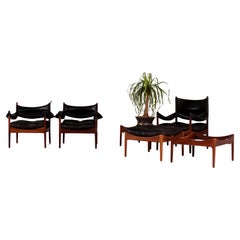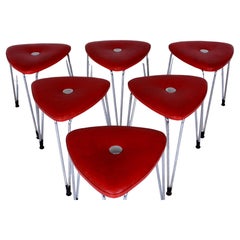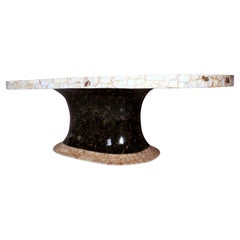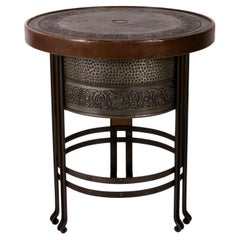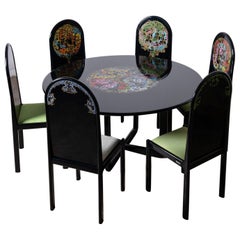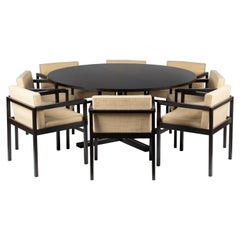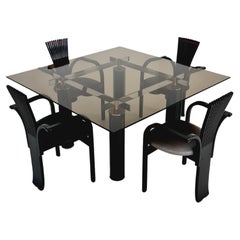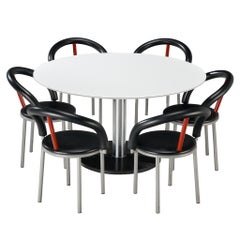Items Similar to Björn Wiinblad for Rosenthal limited art series dining room set table & 8 chairs
Want more images or videos?
Request additional images or videos from the seller
1 of 21
Björn Wiinblad for Rosenthal limited art series dining room set table & 8 chairs
$23,552.87per set
£17,547.64per set
€19,800per set
CA$33,044.47per set
A$36,306.40per set
CHF 18,722.98per set
MX$434,987.44per set
NOK 237,724.21per set
SEK 223,094.51per set
DKK 150,835.83per set
About the Item
THE FOUR CARDINAL POINTS
Rosenthal Kunstmöbelreihe
This noteworthy design is the work of Bjørn Wiinblad.
The furniture pieces were produced in a limited edition of 300 in 1976.
Each table and chair is an original print, rendering each piece a unique entity. The prints were produced by hand under the artist's supervision at the Herbert Geier screen printing studio in Ingolstadt, Southern Germany. The serigraphy technique was employed, utilizing 18 colors. Each item is individually signed and numbered in accordance with the artist's specifications, as outlined in the original contract. The collection comprises a nine-piece ensemble, consisting of eight chairs and a substantial dining table. The material is a black lacquered hardwood.
The set is in remarkable condition and, in this author's estimation, is the most well-preserved set of Wiinblads' "The Four Cardinal Points" art furniture that can be found worldwide.
The dimensions of the set are as follows: the diameter of the dining table is 145 centimetres, and its height is 72 centimetres - the tableboard is reversible.
The chairs have a seat height of 45 centimetres, a depth of 45 centimetres, a width of 43 centimetres, and a total height of 111 centimetres.
About the artist:
Bjørn Wiinblad (1918-2006) is regarded as an artist of considerable versatility, continually reinterpreting himself and his work in pursuit of novel avenues and materials for embellishment.
Fairytale designs imbued with a sense of joy.
Björn Wiinblad's creative output was characterised by a multifaceted approach to artistic expression. He painted oriental ladies and mythical creatures, creating works that evoke joy, fairy tales, and fantasy at a time when minimalism was prevalent. Wiinblad made significant contributions to various artistic disciplines, demonstrating a lifelong dedication to decoration through painting. His unwavering creativity, exuberant Oriental style, and exceptional talent established him as a seminal figure in Danish art, celebrated for his multifaceted contributions to the visual arts.
The Danish artist Bjørn Wiinblad, illustrator, and ceramicist, evinced an early proclivity for artistic pursuits. He was born in Copenhagen in 1918.
He pursued studies in fine art at the Royal Danish Academy of Fine Arts in Copenhagen, graduating in 1943. In 1946, he commenced employment with the Danish pottery Nymølle, which he subsequently assumed control of in 1976. In 1952, he established his own design studio and subsequently commenced employment with the German porcelain manufacturer Rosenthal. In 1957, he was promoted to the position of lead designer for Rosenthal, which provided him with the opportunity to travel throughout Europe and gain international recognition.
In contrast to his contemporaries, who were preoccupied with functional aesthetics, Wiinblad's style was characterized by a delicate and romantic sensibility, with a proclivity for rich colors and undulating lines. These elements were frequently inspired by the fairy tale tradition. His dedication to soulful ceramic design is exemplified by the iconic Magic Flute series (1959) for Rosenthal, a meticulously crafted table service that pays homage to Mozart's opera The Magic Flute. Additional noteworthy designs for Rosenthal include the Romance series (1959), the 1001 Nights series (1969), and the Quatre Couleurs series (Sixties).
While Wiinblad is primarily recognized for his contributions to ceramic design, he also engaged with a diverse range of other artistic mediums. In 1947, he was commissioned by the American Embassy in Paris to design a series of posters. Concurrently, he initiated his career as a costume and set designer for the Royal Theater in Copenhagen, creating designs for Lysistrata (1949), Undine (1962), and Hans Christian Andersen's The Swineherd (1969).
Wiinblad's oeuvre is represented in numerous museums and permanent collections across the globe, including the Victoria & Albert Museum in London, the Museum of Modern Art in New York, and the National Museum in Stockholm.
shipping:: Shipping ::
I'd be more than happy to offer you the most competitive shipping option if you just provide me with your postcode!
For the fastest and most secure shipping, your item will be shipped by us: air freight and perfectly packed in a custom-made wooden OSB board box on pallet (aprox. 160cms x 140cms x 175cms high) DAP (Delivery At Place).
- Creator:Bjorn Wiinblad (Artist)
- Dimensions:Height: 27.96 in (71 cm)Diameter: 57.09 in (145 cm)Seat Height: 17.72 in (45 cm)
- Sold As:Set of 9
- Style:Space Age (Of the Period)
- Materials and Techniques:
- Place of Origin:
- Period:
- Date of Manufacture:1974
- Condition:
- Seller Location:Landshut, DE
- Reference Number:1stDibs: LU8587242509032
About the Seller
5.0
Vetted Professional Seller
Every seller passes strict standards for authenticity and reliability
1stDibs seller since 2023
22 sales on 1stDibs
Typical response time: 7 hours
- ShippingRetrieving quote...Shipping from: Bodenkirchen , Germany
- Return Policy
Authenticity Guarantee
In the unlikely event there’s an issue with an item’s authenticity, contact us within 1 year for a full refund. DetailsMoney-Back Guarantee
If your item is not as described, is damaged in transit, or does not arrive, contact us within 7 days for a full refund. Details24-Hour Cancellation
You have a 24-hour grace period in which to reconsider your purchase, with no questions asked.Vetted Professional Sellers
Our world-class sellers must adhere to strict standards for service and quality, maintaining the integrity of our listings.Price-Match Guarantee
If you find that a seller listed the same item for a lower price elsewhere, we’ll match it.Trusted Global Delivery
Our best-in-class carrier network provides specialized shipping options worldwide, including custom delivery.More From This Seller
View AllMODUS by Kristian Solmer Vedel SET of 3 lounge chairs 1 stool & 2 coffee tables
By Kristian Solmer Vedel
Located in Landshut, BY
This set was designed by Kristian Solmer Vedel for the renowned Søren Willadsen Møbelfabrik in Denmark.
It boasts excellent original condition.
The set includes two lounge armchair...
Category
Vintage 1960s Danish Scandinavian Modern Stools
Materials
Aluminum
SET of SIX mid-century STOOLS by Günter Talos Vienna chrome iron pin legs 1950s
By Günter Talos
Located in Landshut, BY
SOLID HEAVY DUTY MADE FOR THE ETERNITY
Six mid-century stools designed and made in Vienna around 1950 by J. A. Talos, Vienna XII. Bezirk , Dörfelstraße 6-8 .
The architectually sig...
Category
Vintage 1950s Austrian Mid-Century Modern Stools
Materials
Chrome, Iron
$3,083 Sale Price / set
41% Off
Marble Oval Tulip Dining or Conference Table Muller's of Mexico with Brass Inlay
By Muller of Mexico
Located in Landshut, BY
The table is an exquisite and unique piece of craftsmanship, hand-made in the 1970s by Muller of Mexico. It is crafted from green and ebony colour marble, with a lined surface of ov...
Category
Vintage 1970s Mexican Mid-Century Modern Dining Room Tables
Materials
Marble, Brass
$14,536 Sale Price
35% Off
an extremely rare French Art Nouveau side table Paris ar. 1905 iron brass zinc
By Hector Guimard
Located in Landshut, BY
Bonjour !
This object is a gem, and in this rare version it features a riveted wrought iron frame with hammered zinc sheet fixed to a wooden panel. The panel has artistically desig...
Category
Antique Early 1900s French Art Nouveau Side Tables
Materials
Iron, Brass, Zinc
One of a Kind Italian Midcentury Sideboard with Bar Cabinet a. Vittorio Dassi
By Vittorio Dassi
Located in Landshut, BY
Italian 1950s
one of a kind
BAR / SIDEBOARD
attributed to Vittorio Dassi
birch root veneer - solid birch "feet" - stained glass top - mirrored bar compartment - carved upper orna...
Category
Vintage 1950s Italian Mid-Century Modern Sideboards
Materials
Stained Glass, Burl, Birch
Duilio " Dubé " Bernabe Italian coffee table Marble and Bronze Relief
By Duilio Dubé Bernabe
Located in Landshut, BY
It is our great pleasure to confirm that both the stand and the board are, in fact, original and remain in their original condition.
This rectangular coffee table was designed by D...
Category
Vintage 1950s Italian Mid-Century Modern Coffee and Cocktail Tables
Materials
Carrara Marble, Brass
$2,360 Sale Price / set
76% Off
You May Also Like
Dining Set "Die vier Himmelsrichtungen" by Bjorn Wiinblad for Rosenthal
By Rosenthal, Bjorn Wiinblad
Located in Dallas, TX
Dining set "Die vier Himmelsrichtungen" - "The Four Cardinal Points". This is an exceptional, very beautiful and unique dining set that consist of dining table with six chairs design...
Category
Vintage 1970s German Scandinavian Modern Dining Room Sets
Materials
Wood, Lacquer, Paint
Mid-20th Century Wengé Dining Table with 8 Matching Chairs Jules Wabbes style
By Jules Wabbes
Located in Casteren, Noord-Brabant
Beautiful large round wenge dining table with 8 matching chairs in the style of Jules WABBES. The table can be extended with two original leaves. If there are 6 chairs at the table, ...
Category
Vintage 1970s Belgian Mid-Century Modern Dining Room Sets
Materials
Iron
4 Totem dining chairs by Torstein Nilsen for Westnofa, Italian design table
By Vintage Italian Glass, Westnofa Furniture, Torstein Nilsen
Located in Gaggenau, DE
Set of 4 Mid Century Totem dining chairs by Torstein Nilsen for Westnofa with Italian design dining table .Norway 1980s
Beautiful vintage Set of 4 dining chairs, with table ,model Totem, by Torstein Nilsen for Westnofa, Norway.
They are in black wooden fram with feathering slats back, between the slats red wooden balls. 2 chairs seats are black leather other 2 is in dark grey Leather furnishing.
Dining Table is a very special and luxurious vintage Italian design piece. It’s from 1980s
It’s the combination of Black metal hexagon-shaped legs.
Spacers in copper and beveled glass panel complete its design.
It will be the accent of any dining room.
Dimensions
Chairs
width 55 cm
Seat height 51 cm.
Total depth 56 cm
Total height 87 cm
Height arm rests 65.2 cm.
Table -120 cm x 120 cm
Height 72.5 cm
Year -1980's.
In very good condition with minimal wear
You can order 4 set chairs...
Category
Vintage 1980s Norwegian Mid-Century Modern Dining Room Sets
Materials
Brass, Chrome
Postmodern Dining Room Set with Anna Anselmi Chairs and Round Table
Located in Waalwijk, NL
Round table, stone, laminated wood, chromed metal, Europe, 1970s
Made in Europe in the 1970s, this round table features a minimalist design with a strong material presence. The base...
Category
Vintage 1970s European Post-Modern Dining Room Tables
Materials
Faux Leather
Mid-Century Modern Set of Dining Table and 6 Chairs by Móveis Flama, Brazil
Located in Deerfield Beach, FL
Mid-Century Modern set of dining table with six chairs by Brazilian Manufacture Móveis Flama, 1950s
This set comprises 1 (one) dining table and 6 (six) chairs. Designed in the 1950s...
Category
Vintage 1950s Brazilian Mid-Century Modern Dining Room Chairs
Materials
Faux Leather, Formica, Wood
$16,480 Sale Price / set
20% Off
Dining Table Set by Pierre Cardin for Roche Bobois, 1970s, Set of 6
By Roche Bobois
Located in Montelabbate, PU
Dining room set by Pierre Cardin for Roche Bobois, 1970s. Black lacquered wood set consisting of four chairs, a table and a sideboard. The table has an extendable glass top (extensio...
Category
Vintage 1970s Italian Modern Dining Room Sets
Materials
Glass, Wood, Lacquer
$5,947 Sale Price / set
33% Off
More Ways To Browse
Bjorn Wiinblad Art
Rosenthal Romance
Drexel Dining Room Table And 6 Chairs
Eero Aarnio Upo
Green Woodard Patio Set
Hans Olsen Round Table
Hans Wegner Heart Table
Hitchcock Dining Table
Roundette Dining Table
Roundette Table
Teak Tile Hermann
Wegner Heart Table
Western Dining Chairs
Windsor Table And Chairs
1980s Dinette Set
43inch Round Dining Table
Arthur Umanoff Outdoor
Burke Table And Chairs
